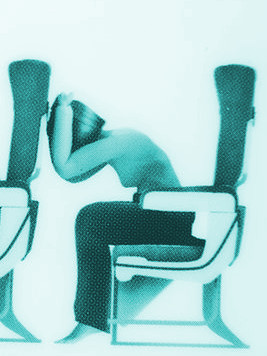Expert gives leg space warning
 The lack of leg space on commercial flights could prevent passengers from bracing in a plane crash.
The lack of leg space on commercial flights could prevent passengers from bracing in a plane crash.
Chair of the International Board for Research into Aircraft Crash Events (IBRACE), Jan Davies, has told the SafeSkies aviation safety conference in Canberra that limited leg space could have an impact on passenger safety in emergencies.
“The seat pitch is the distance essentially between the back of the seat in front of you and your seat back, and airlines have been reducing that distance over the last decade or so,” she said.
“They want to get more passengers in. That means it's harder to assume the brace position.
“If your seat pitch is less than 30 inches [76.2cm], you will not be able to brace properly if you are of average height … as well as if you are a tall person or a larger person, because there's just not much space.”
Professor Davies said an average height person is likely to end up in one of two incorrect bracing positions in a seat with a 29-inch (73.7cm) pitch.
Taller people often brace with their head tilted, rather than being positioned straight on as they attempt to brace.
Other arch their back with the heels of their feet off the ground, again in an attempt to brace.
Jetstar's Airbus A320 and A321 have seat pitches of 29 inches and 28 inches (71.1cm) in some of their economy seats, while Tigerair Australia's Airbus A320 has a seat pitch of 72.5cm, or less than 29 inches, in some of its economy seats.
Professor Davies said her analysis of existing research was concerning.
“We know if you're in a 28-inch pitch seat, you and your fellow passengers will brace each other because you'll be in there like little sardines in a tin,” she said.
“You may not bounce around as much, but your heads will still be at risk because there won't be much to stop your head from going forward.
“Once you get up to at least 30 inches, then you can start to brace yourself.”
The Civil Aviation Safety Authority (CASA) says it “has no evidence that any seat pitch used by Australian airlines is a risk to safety”.
“We will always look to adopt world's best practice in cabin safety and any changes in ICAO (International Civil Aviation Organisation) standards will be carefully evaluated,” a spokesperson said.
Many doubt that a person’s seating position would have any effect in the event of a crash, but Professor Davies said the correct brace position can save lives.
“If you go through old crashes and see where people braced and didn't brace it really does make a difference,” she said.
“If you don't brace, you flail.
“So if the plane hits the ground or the mountain, that's the primary impact and then your body starts hitting things,” she said.
“You bounce around flailing ... and that's where your brain is injured, your face is smashed, your arms and legs are smashed, if you don't brace.”
Professor Davies said IBRACE was working on a single, universal brace position for all passengers in forward-facing economy seats equipped with a lap belt.
“It would make it easier for passengers, no matter where they fly in the world, no matter what language they read or speak, what language they read or their comprehension abilities are,” she said.
“They know there's one brace position if they're sitting in economy.”







 Print
Print